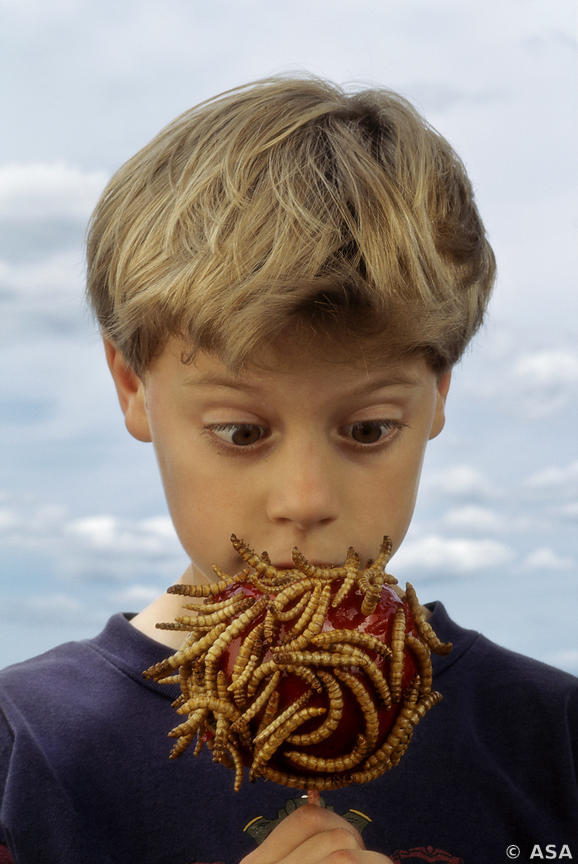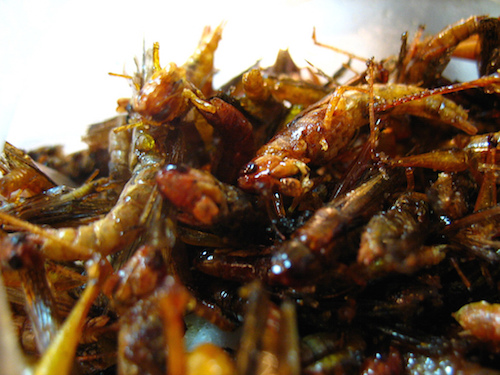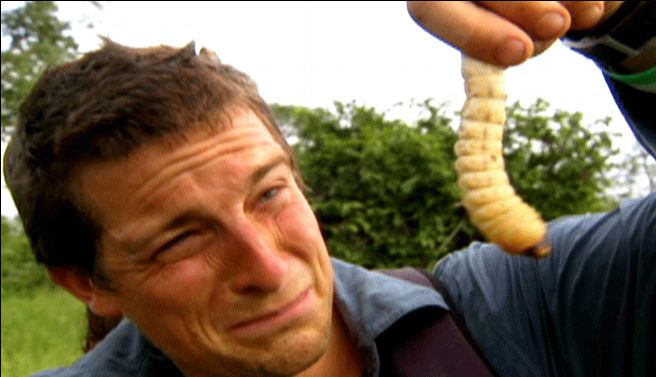Food for a Sustainable Planet
Arnold van Huis, Henk van Gurp, and Marcel Dicke
Francoise Takken-Kaminker and
Diane Blumenfeld-Schaap, Translators
(Columbia University Press)
She was walking with a farmer "somewhere in Burundi in the 1980s." A palm tree had fallen in a recent storm, and when the farmer saw it, she ran ahead and from the "leaf axils just underneath the tree's crown, she triumphantly pulled out a handful of fat white grubs" which she took home and roasted the same afternoon.
- I became curious at her evident delight in this find. And indeed, the small crispy treats were delicious! Shortly thereafter, I was offered honey-flavored, roasted grasshoppers in Syria ... and was by then convinced: insects not only are a good idea nutritionally, but also taste wonderful.
The leap here, we suppose, is that tiny space, the very gap that so perplexed T. S. Eliot: the quarter or eighth inch between the thought and the act; the potential and the kinetic; or even, perhaps, the interval between the physical and the spiritual.
For some of us it would take more than T. S. Eliot and a farm lady out of the wilds of Burundi plucking wiggly things out of a tree-stump and roasting them and stuffing them in her mouth ... perhaps even smacking her lips ... before we'd want to follow her lead. Most of us American's have had years and years of anti-bug brain-washing. These are things we poison, crush, burn, and make disappear. For good reason.
We appreciate Dr. Fresco's concerns about the planet. She knows, as anyone who lives in the 21st century must know, that our consumption of animal protein --- cows, chickens, pigs --- is, as she writes, "directly harming the world we live in, and is unnecessarily harmful to us and our children. A large intake of animal protein is also directly linked to lifestyle-related diseases in wealthy countries."
Ms. Fresco notes that in the Bible there are chapters all in favor of eating grasshoppers (in Leviticus) and also chapters full-bore against such vittles (in Deuteronomy). These are the beginnings of what she calls our "food taboos." The forbidden fruit, obviously filled with contradictions. For instance, we savor creatures from the sea that closely resemble insects --- shrimp, lobster, crawfish, crabs, shelled things with slimy things inside (oysters, clams). We don't refer to them as insect-like; rather; we name them "seafood" or "fruit of the sea." Some of us even tolerate ---- no, are fairly enamored of --- vermin such as snails. In the shell. Stuffed with parsley, garlic and butter. Cooked quickly in a broiler, and presented to the diner with special tongs for extracting it from the shell so you can quickly pop it into your mouth.
With all that in mind, we should tell you that, once you get past the "ork" factor in The Insect Cookbook, it is chock-full of fascinating items, nicely prepared, ones you'd never expect to meet up with in the pages of a cookbook. There are some fine pictures here of dishes prepared, along with photographs of actual people actually chowing down these actual buggers. Writer Arnold van Huis is shown consuming crickets in Laos; Marcel Dicke appears using chopsticks to down a salad of mealworms. None look the worst for wear. Except the mealworms.
There are recipes, highly detailed, familiar dishes with an unusual addendum: jambala coupled with grasshoppers and mealworms; chocolate cake melded with buffalo worms ("use your imagination to decorate the cake"); fried wonton containing "coarsely chopped" mealworms. Chile con Carne with "1/2 cup buffalo worms, 1/4 cup of mealworms." Kebabs with tomato, corn slices, mushroom, avocado and grasshopper ("legs and wings removed.") And some absolutely delicious looking crépes made with raisins and their raisin look-alike, buffalo worms.
Since buffalo worms and meal worms appear so frequently here, we took the time to check them out. And what we learned: maybe you should wait a bit before letting them become your aperitif-of-the-week.
Meal worms are officially known by those in the know as Tenebrio molitor. It is a species of --- poetic name --- "the darkling beetle. "Buffalo worms" are meal worms with a twist; they are known as the "Lesser Meal Worm." May the Good Lord protect us from the "Grosser Meal Worm."
Wikipedia tells us that "it is known widely as a pest insect of stored food grain products such as flour, and of poultry-rearing facilities." And --- are we salivating yet? --- "It is a vector of many kinds of animal pathogens."
Buffalo worms are found everywhere except in the Arctic and Antarctic. It got its name because it roams the Plains getting shot by cowboys and indians, although because of its weenie size, it is often dispatched by boot-heels or even bare feet. It does not look edible when smushed like this, but some people will do anything for to preserve the ecology of the planet. Excuse me: I got waylaid by a blast of actuality for a moment there
We are told that "There are currently no agents of biological pest control in use against the lesser mealworm." Maybe that is why they are trying to sell us on eating these little bastards just to keep their number under control, keep them from consuming our chickens, cows, pigs ... and perhaps ourselves.
Don't let what I've reported discourage you: there are restaurants that are serving these wriggly little buggers; and these restaurants seem to be prospering.
One I especially like is a Michelin two-star, Noma in Copenhagen. The Chef, René Redzepi, is especially fond of ground ant --- that is, ant ground to fine dust. He traditionally makes this powder into a paste "to flavor foodstuffs." Beetles? He's keen on them too. He likes to mash them to a powder, in which he rolls carrots, which, when grilled, turn "browned and tasty."
He also mixes ant with "fermented cricket" which, he says, "explodes in your face." He has learned cooking techniques from the street foods of other countries. For example, he found a dish of ant eggs in Mexico. It's called escamoles or "ant caviar."
- Stewed together with spices and tomatoes, it was a magnificent flavor and [is] very tasty.
If the very title of this book gives you the willies, you might as well give up right now. You're already eating them. Bugs, mould, leavings of rats and mice: they are already in your diet. Even copiously.
You probably have never heard of the Food and Drug Administration's "Defect Levels." It's a fairly lengthy list. If you prefer to be ignorant of some of your novel eating habits, you might want to stop reading what we have to say at this very point. For a certain percentage of mold, "animal parts," "filth: (rodent and insect)" as well as, unh, "Mammalian excreta" is permitted to nest there, in your shopping cart, an intimate part of your store-bought food, perhaps nestling even in those chips are nibbling on right now --- here, have another --- even possibly part of your cheese dip. Or even, perhaps, a friendly adjunct to what you have scheduled for supper, or, yum, even in your dessert.
§ § § The proper name is "DEFECT ACTION LEVELS" (the FDA page last updated 07/10/2014). You'll find it all at
https://www.fda.gov/food/ingredients-additives-gras-packaging-guidance-documents-regulatory-information/food-defect-levels-handbookThe table lists such foods as pineapple, beans, olive, spices, fruit in which contaminants may not exceed an exact permitted level. There you'll find that Apple Butter is acceptable with less than an "Average of mold count 12%;" or Rodent filth ("four of more rodent hairs per 100 grams;") or insects "Average of 5 or more whole or equivalent insects (not counting mites, aphids, thrips, or scale insects) per 100 grams of apple butter."
Attention chocolate lovers: insect filth permitted must average "less than 60 or more insect fragments per 100 grams; Rodent filth Average is 1 or more rodent hairs per 100 grams." For those fond of Red Fish and Ocean Perch: no more than "3 % of the fillets examined [may] contain 1 or more copepods accompanied by pus pockets." Popcorn. The acceptable level is breached if "1 or more rodent excreta pellets are found in 1 or more subsamples, and 1 or more rodent hairs are found in 2 or more other subsamples" OR
"2 or more rodent hairs per pound and rodent hair is found in 50% or more of the subsamples"
OR
"20 or more gnawed grains per pound and rodent hair is found in 50% or more of the subsamples"
With peanut butter, the FDA seems to be somewhat more strict. Insect filth permitted: Average of 30 or more insect fragments per 100 grams
Rodent filth Average of 1 or more rodent hairs per 100 grams
Wheat: Insect damage Average of 32 or more insect-damaged kernels per 100 grams, and Rodent filth: Average of 9 mg or more rodent excreta pellets and/or pellet fragments per kilogram
Pepper, Whole (Black & White) --- the limits are: Insect filth and/or insect-mold: Average of 1% or more pieces by weight are infested and/or moldy
Mammalian excreta Average of 1 mg or more mammalian excreta per pound.
§ § § Thus, if you were made uneasy by a volume called "The Insect Cookbook," you now probably know (or can easily guess) that you've been experiencing --- that is putting in your mouth, then chewing, then swallowing --- such yucky comestibles for a very long time, probably your whole life.
Thus your daily bread has been regularly enriched with a variety of wriggly but dead beetles, spiders, earwigs, flies, mites, ticks and ground-up centipedes, complete with all their many leavings and skeletal parts: thorax, spiracles, fangs, eyes, mandibles, pedipalps, wings.
You've been indulging in this mountain of tiny scabrous materials monthly, weekly, daily, perhaps hourly. Or at least as long as you've been living under th less-than-onerous rules of our ever-vigilant, ever-protective federal government. Protecting you, and our loved ones, working hand-in-hand with the farmers and producers and distributors of many foodstuffs so we can move smartly into the future, secure in the knowledge that our victuals of hamburger, fried chicken, hot dogs, meat loaf, soups, salads, chips, dips and weekend treats are at once more diverse, even richer and more varied than we could ever have suspected.


